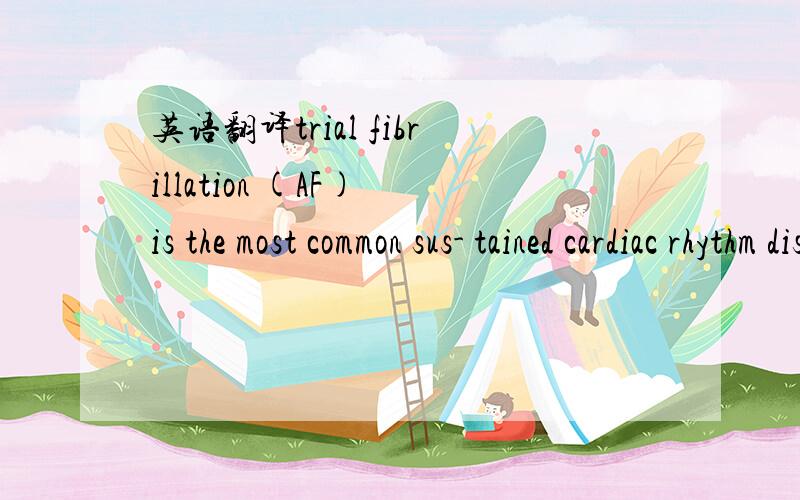英语翻译trial fibrillation (AF) is the most common sus- tained cardiac rhythm disorder,which is associ- ated with a substantial risk of mortality and morbidity from stroke and thromboembolism (TE).A substan-tial evidence base is in favor of antic
来源:学生作业帮助网 编辑:作业帮 时间:2024/11/24 13:12:17

英语翻译trial fibrillation (AF) is the most common sus- tained cardiac rhythm disorder,which is associ- ated with a substantial risk of mortality and morbidity from stroke and thromboembolism (TE).A substan-tial evidence base is in favor of antic
英语翻译
trial fibrillation (AF) is the most common sus- tained cardiac rhythm disorder,which is associ- ated with a substantial risk of mortality and morbidity from stroke and thromboembolism (TE).A substan-
tial evidence base is in favor of anticoagulation with the vitamin K antagonists (VKAs,eg,warfarin),which reduce this risk by two-thirds,whereas antiplatelet therapy decreases stroke risk only by 22%.1 VKAs are
clearly superior to aspirin for stroke prevention,even in patients with AF aged 75 years.For example,in the Birmingham Atrial Fibrillation Treatment of the Aged (BAFTA) Study,the use of VKA (INR 2-3) reduced the primary end point of TE by 52% compared with aspirin 75 mg daily,with no difference in major bleeding events between VKA or aspirin.2 Even in low- risk subjects with AF,aspirin may be no better than control for reducing TE events,with a tendency to more adverse effects (especially bleeding) with aspirin.3
The risk of stroke and TE in AF is not homoge- neous,and various clinical and echocardiographic features have been identified to help stratify risk into high-,intermediate-,or low-risk categories.1 How- ever,contemporary clinical risk stratification schema for predicting stroke,transient ischemic attack (TIA),or TE for patients with AF are largely derived from risk factors identified from non-VKA arms of trial cohorts,and one cohort study (Framingham).Thus,many potential risk factors have not been adequately assessed,as not all potential risk factors have been systematically documented in the clinical trial popu- lations.The Stroke in AF Working Group4 performed a systematic review of these stroke risk factors and concluded that only four clinical features (prior stroke/TIA,advancing age,hypertension,and diabetes) were consistent independent risk factors.Also,existing stroke risk stratification schema have widely varying proportions categorized into high-,intermediate-,and low-risk strata,and are generally of modest pre- dictive value in predicting stroke and TE (C-statistics of approximately 0.6).5 Again,some of the validation studies comparing the performance of different schema are limited by having been performed in anticoagulated trial cohorts,6 retrospective analyses of anticoagulated AF registries,7 and in some,non-VKA arms of trial cohorts whereby antiplatelet therapy and/or subtherapeutic VKA (eg,INR ,1.5) were used.
英语翻译trial fibrillation (AF) is the most common sus- tained cardiac rhythm disorder,which is associ- ated with a substantial risk of mortality and morbidity from stroke and thromboembolism (TE).A substan-tial evidence base is in favor of antic
试验颤动(AF)是最常见的见sub -弃权票心脏节奏障碍,即是其associ——与极可能的发病率和死亡率中风和血栓(TE).一个substan -
基地在农村生态人居证据支持抗凝维生素K拮抗剂(VKAs,例如,华法林),减少这种风险以三分之二,而抗血小板治疗中风的风险降低VKAs只有22%.1
阿斯匹林者能够明显优于常规中风预防,即使在房颤病人年龄在75岁.例如,在伯明翰房颤治疗老年学院奖)研究,使用VKA(INR 3)降低了主要终点TE的阿斯匹林的相比最高达52% 75毫克每天以来,在主要的没有区别VKA或aspirin.2之间出血风险低,甚至在主题房颤、阿司匹林可能不比控制事件(减少TE倾向于更多的负面影响和aspirin.3(特别是出血)
卒中风险的房颤和网球是不homoge - neous,和各种各样的临床和超声心动图的特征,可以帮助确认系统成高,风险,中间,或低风险的categories.1 -永远,当代临床危险分层模式来预测中风、短暂性脑缺血发作(TIA),或TE为房颤病人在很大程度上是来自危险因素non-VKA武器试验了大量,一个队列研究(弗莱明翰).因此,许多潜在的危险因素没有充分评估,潜在的危险因素,因为不是所有本文系统地记录在临床试验,与你不相关或是不爱措施.工作Group4房颤划作了一个系统性的回顾一下这些中风的风险因素,并得出结论说只有四个临床特征(之前卒中/短暂性缺血(岁数愈来愈大,高血压和糖尿病是一致的独立危险因素.同时,现有的中风的风险比例大不分层模式分为高-,中级-,和低风险的阶层,通常有适度的售前dictive价值C-statistics预测中风和特(大约为0.6)5再者,一些验证研究对的表现,不同模式是有限的,而在此之前,anticoagulated试验进行了回顾性分析大量,6 anticoagulated房颤登记处、7和在一些地方,non-VKA武器的试验的大量,抗血小板治疗和/或subtherapeutic VKA(如INR、1.5分析方法.
试验颤动(AF)是最常见的见sub -弃权票心脏节奏障碍,即是其associ——与极可能的发病率和死亡率中风和血栓(TE)。一个substan -
基地在农村生态人居证据支持抗凝维生素K拮抗剂(VKAs,例如,华法林),减少这种风险以三分之二,而抗血小板治疗中风的风险降低VKAs只有22%.1
阿斯匹林者能够明显优于常规中风预防,即使在房颤病人长者...
全部展开
试验颤动(AF)是最常见的见sub -弃权票心脏节奏障碍,即是其associ——与极可能的发病率和死亡率中风和血栓(TE)。一个substan -
基地在农村生态人居证据支持抗凝维生素K拮抗剂(VKAs,例如,华法林),减少这种风险以三分之二,而抗血小板治疗中风的风险降低VKAs只有22%.1
阿斯匹林者能够明显优于常规中风预防,即使在房颤病人长者
收起
审判心房颤动(房颤)是最常见的技能提升计划不引起心律紊乱,这是associ与死亡率和发病率的中风和血栓栓塞(TE)的巨大风险ated。阿substan -
TiAl基证据基础是(VKAs,如华法林),从而降低这个三分之二的风险,而抗血小板治疗减少中风的危险,只有22%.1 VKAs是与维生素K拮抗剂抗凝青睐
明显优于阿司匹林预防中风,甚至在75岁房颤患者。例如,在伯明翰减少治疗...
全部展开
审判心房颤动(房颤)是最常见的技能提升计划不引起心律紊乱,这是associ与死亡率和发病率的中风和血栓栓塞(TE)的巨大风险ated。阿substan -
TiAl基证据基础是(VKAs,如华法林),从而降低这个三分之二的风险,而抗血小板治疗减少中风的危险,只有22%.1 VKAs是与维生素K拮抗剂抗凝青睐
明显优于阿司匹林预防中风,甚至在75岁房颤患者。例如,在伯明翰减少治疗心房颤动的老年人(英国影艺学院)研究中,维生素K拮抗剂(印度卢比2-3)用52%的TE的主要终点比每天75毫克阿司匹林,没有差异主要出血与维生素K拮抗剂或aspirin.2即使事件与AF低风险科目,阿司匹林可减少TE的活动,同一种倾向与aspirin.3更多(尤其是出血)的不利影响,没有优于对照
中风的风险和房颤TE是不是均匀的,各种临床及超声心动图功能已被确定为帮助分层为高,中级,或低风险categories.1如何有史以来,当代临床危险分层架构的风险预测中风,短暂性脑缺血发作,或TE与自动对焦主要是来自非维生素K拮抗剂武器试验世代,一个世代研究(Framingham的)风险因素的派生患者(TIA)的。因此,许多潜在的危险因素并没有得到充分的评估,因为不是所有的潜在风险因素进行了系统的临床试验popu - lations记录。在自动对焦工作组别4行程进行了中风的危险因素,这些系统的审查,并得出结论,只有四个(前卒中/ TIA,年龄增长,高血压和糖尿病)是一致的独立危险因素,临床特点。另外,现有的中风危险分层模式会有不同分为高,中级和低风险的地层划分比例,并在预测中风和TE(的C约0.6统计)0.5同样普遍温和预dictive价值,审定比较不同模式的性能是有限的一些研究曾在抗凝试验同伙,6房颤抗凝登记回顾性分析,7,在一些演出,试同伙非维生素K拮抗剂的武器,即抗血小板治疗和/或subtherapeutic维生素K拮抗剂(如印度卢比,1.5)被用来
收起
审判心房颤动(房颤)是最常见的技能提升计划不引起心律紊乱,这是associ与死亡率和发病率的中风和血栓栓塞(TE)的巨大风险ated。阿substan -
TiAl基证据基础是(VKAs,如华法林),从而降低这个三分之二的风险,而抗血小板治疗减少中风的危险,只有22%.1 VKAs是与维生素K拮抗剂抗凝青睐
明显优于阿司匹林预防中风,甚至在75岁房颤患者。例如,在伯明翰减少治疗...
全部展开
审判心房颤动(房颤)是最常见的技能提升计划不引起心律紊乱,这是associ与死亡率和发病率的中风和血栓栓塞(TE)的巨大风险ated。阿substan -
TiAl基证据基础是(VKAs,如华法林),从而降低这个三分之二的风险,而抗血小板治疗减少中风的危险,只有22%.1 VKAs是与维生素K拮抗剂抗凝青睐
明显优于阿司匹林预防中风,甚至在75岁房颤患者。例如,在伯明翰减少治疗心房颤动的老年人(英国影艺学院)研究中,维生素K拮抗剂(印度卢比2-3)用52%的TE的主要终点比每天75毫克阿司匹林,没有差异主要出血与维生素K拮抗剂或aspirin.2即使事件与AF低风险科目,阿司匹林可减少TE的活动,同一种倾向与aspirin.3更多(尤其是出血)的不利影响,没有优于对照
中风的风险和房颤TE是不是均匀的,各种临床及超声心动图功能已被确定为帮助分层为高,中级,或低风险categories.1如何有史以来,当代临床危险分层架构的风险预测中风,短暂性脑缺血发作,或TE与自动对焦主要是来自非维生素K拮抗剂武器试验世代,一个世代研究(Framingham的)风险因素的派生患者(TIA)的。因此,许多潜在的危险因素并没有得到充分的评估,因为不是所有的潜在风险因素进行了系统的临床试验popu - lations记录。在自动对焦工作组别4行程进行了中风的危险因素,这些系统的审查,并得出结论,只有四个(前卒中/ TIA,年龄增长,高血压和糖尿病)是一致的独立危险因素,临床特点。另外,现有的中风危险分层模式会有不同分为高,中级和低风险的地层划分比例,并在预测中风和TE(的C约0.6统计)0.5同样普遍温和预dictive价值,审定比较不同模式的性能是有限的一些研究曾在抗凝试验同伙,6房颤抗凝登记回顾性分析,7,在一些演出,试同伙非维生素K拮抗剂的武器,即抗血小板治疗和/或subtherapeutic维生素K拮抗剂(如印度卢比,1.5)的使用。
收起